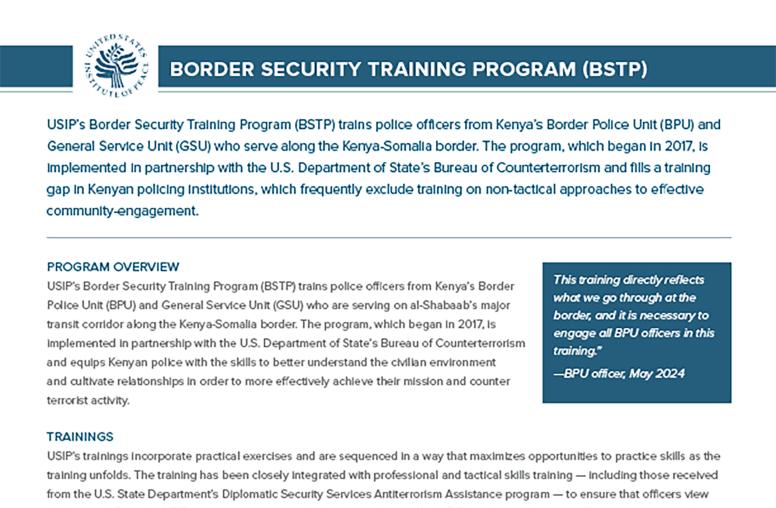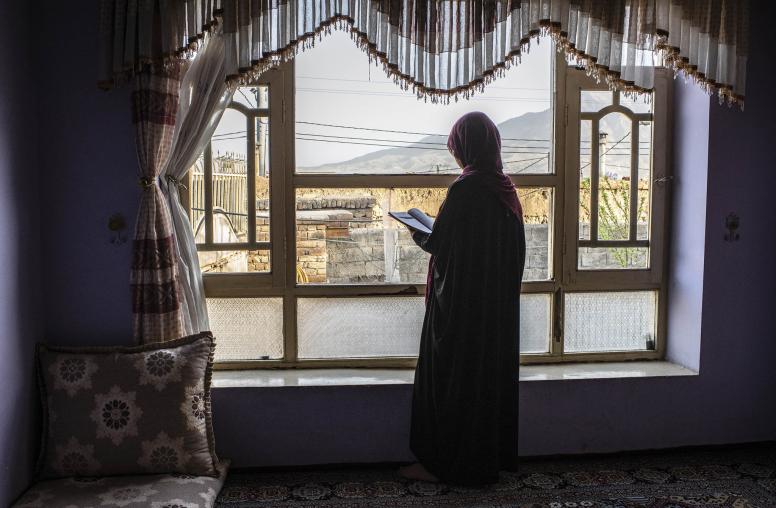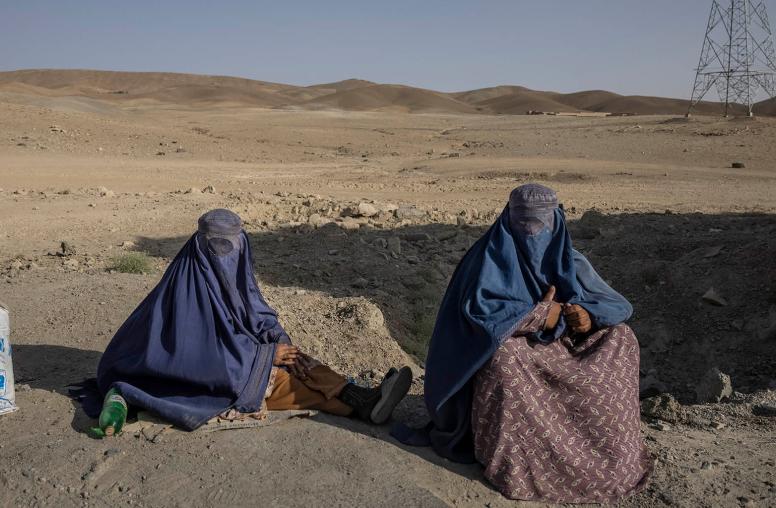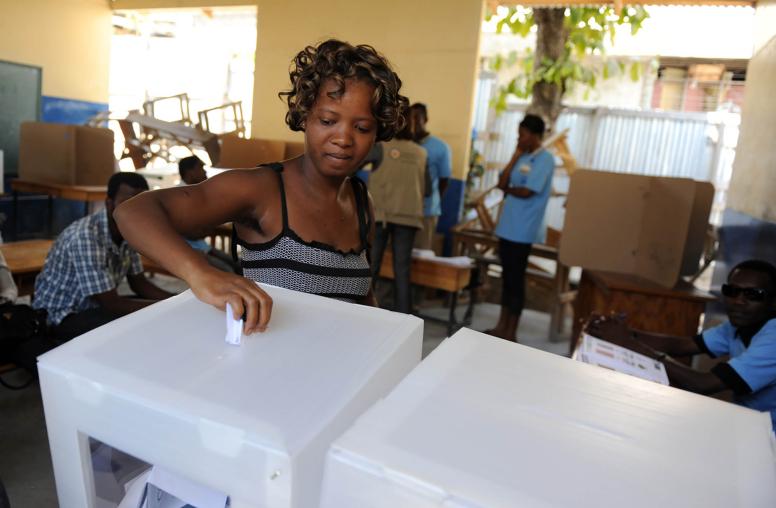Toward a Gender-Inclusive National Security Strategy
When it comes to women, peace and security, defense officials say the U.S. must lead by example.
With the Women, Peace and Security (WPS) Act of 2017, the United States is the only country in the world to codify into law women’s critical role in building peace and security. The law requires the Department of Defense, among several U.S. government agencies, to create strategies that prioritize the perspectives, safety and meaningful participation of women across all facets of national security — a critical factor in addressing the complex challenges facing the United States.

Women: A Common Denominator for Peace
“Virtually every dimension of national security is tied to whether women are subordinated or whether they are empowered,” said Valerie Hudson, a professor and chair at Texas A&M University. Speaking at a USIP-hosted virtual event, Hudson and the other panelists said that time and again, both research and experience have revealed just how vital the elevation and inclusion of women is for creating sustainable peace.
In looking at 166 outcome variables for a nation, Hudson found a “striking” correlation between the subjugation of women and adverse results for the country in question. “For every step one takes in subjugating women, you have twice the chance of being a fragile state … a [50% increased] chance of being unstable and violent and one-and-a-half times the chance of experiencing terrorism,” said Hudson.
Incorporating indicators of subjugation can help the Department of Defense prepare for possible instability and conflict — as well as prevent these trends in the first place. Understanding the connection between women’s lived experience and broader security issues gives national security actors another, potent tool through which to address challenges.
Leveraging this knowledge serves as a form of “smart power,” said Brigadier General Rebecca Sonkiss, deputy director for counter threats and international cooperation for the Joint Staff J5 — the Pentagon office responsible for strategy and planning. “By understanding the needs of the entire population during conflict, DOD enhances its operational effectiveness … and mitigates disproportionate harm against vulnerable populations.”
Meanwhile, WPS strategies offer an opportunity to improve our national security apparatus from within. “Professional military forces [must] have legitimacy to their populations,” said Admiral Craig S. Faller, commander of U.S. Southern Command. “And that includes the inclusion of women … The strength of our society can and must be reflected inside our formations.”
Both Admiral Faller and his colleague Lieutenant General Michael Minihan, deputy commander of U.S. Indo-Pacific Command, were adamant that integrating women- and gender-inclusive policies at all levels of the military was both the right and smart thing to do. In recounting firsthand experience in implementing these policies, both attested to the dramatic increase in effectiveness that came with the incorporation of women.
Implementing WPS: How Far We’ve Come
The origin of WPS efforts dates back well before the 2017 law. Since 2000, U.N. Security Council Resolution 1325 has laid out a roadmap for countries looking to implement a WPS agenda in both their domestic and foreign policies.
The United States has made diligent progress in the intervening years, but the 2017 law helped coalesce efforts around the first-ever WPS strategic framework. With implementation plans and objectives, the strategic framework allows national security officials to make WPS efforts “part of our DNA, not something we think about as a checklist item,” said Lt. Gen. Minihan.
This integrative aspect is vital, said Hudson, as you can’t “take a few women, sprinkle them into your command, and mix it up and voila.” Instead, the WPS strategic framework focuses on changing the culture and values that have historically precluded women and women-inclusive policies from broader acceptance within the national security apparatus.
The implementation process is also overseen by the Pentagon’s undersecretary for policy, with assistance from the Join Staff J5, meaning that directives for WPS programs are being prioritized at the highest levels of government. Combatant commands have also brought in WPS advisers to influence broader U.S. defense policy. All this has resulted in a titanic shift in WPS policies — funding and program guidance are handed down to the combatant commands, which in turn integrate WPS policies into standard procedures, ensuring that WPS approaches become part of the Defense Department’s routine operation at all levels. “It's taught and integrated in everything we do,” said Admiral Faller. “When you check in, you get educated about it, you get educated about it as part of our monthly training days … every way we can expand the education as part of the bigger purpose: more combat credible ready forces to defend our nation. That’s the approach.”
WPS implementation has also drawn on partners in civil society, as U.S. Strategic Command (abbreviated as STRATCOM) utilizes academic alliances with over 50 universities to produce research on WPS and provide leadership programs for women in command. “We’re hopeful this course will help us improve our critical thinking and enable a more diverse decision making,” said STRATCOM Commander Lt. Gen. Thomas Bussiere.
Internationally, the WPS strategic framework has catalyzed engagement with over 50 nations through conferences and training exercises to demonstrate the value of diversity and inclusion on force readiness. “We know that we can’t do any of this work alone,” said Deputy Secretary of Defense Kathleen Hicks. “[WPS] helps enhance the capacity of our allies and partners to address our shared challenges.”
The international outreach programs have been met with particularly fervent enthusiasm. “The demand is so high in our theater that we are at a sprint pace to keep up with that,” said Lt. Gen. Minihan. Defense officials noted that events focused on bringing personal stories to light have helped allies find practical ways to remove barriers and illuminate the power of integrating a WPS agenda.
Addressing Challenges to WPS
Despite promising signs of progress, the national security apparatus has a long way to go to fully achieving the future laid out in the WPS Act. “If I had a vision, we’d stop hearing ‘this is a first’ because it’s routine and it’s integrated into all our military operations,” said Lt. Gen. Bussiere.
WPS efforts are relatively new for the Defense Department. It wasn’t until the 1990s that the Combat Exclusion Act was lifted, allowing women to serve in active-duty combat roles. But defense officials said there is a deep desire to press forward, and that leaders wanted to be at the forefront of WPS issues.
To do so, national security actors will need to move beyond simply elevating women and address concepts of masculinity and other gender norms that drive conflict and subjugation. When women are oppressed or prevented from participating fully in society, “that’s not coming from the women, that’s coming from how men think of themselves, how men think about the relationship between men and women,” said Hudson.
Pointing to issues with gender-based and sexual violence, both internationally and within the national security apparatus itself, Hudson said the next step is to focus on eliminating the culture and norms that have allowed those things. On that front, she remains hopeful — a view shared by Brigadier General Sonkiss, who pointed to the commitment from her male colleagues: “When the men are at the table … we know we’ve gotten somewhere.”
Again, the United States cannot do this alone. Involving allies, partners and civil society will be critical to the success of WPS strategies. “There’s a wellspring of engaged young people here … we’re looking to you to help us,” said Ambassador Andrew Young, deputy to the commander for civil-military engagement at U.S. Africa Command.
The path forward for WPS amounts to a major reconfiguring of how the Defense Department and national security apparatus have operated in the past. But the moral and strategic benefits of advocating a WPS agenda are well-demonstrated to be worth the effort. “We absolutely acknowledge that there is lots of work to do and this is just the tip of the iceberg,” said Lt. Gen. Minihan. “But we want to lead by example when we show up in our theater.”



